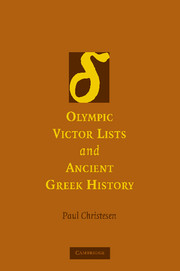Book contents
- Frontmatter
- Contents
- List of Illustrations
- List of Tables
- Preface
- A Note on Terminology, Transliterations, and Editions
- 1 An Introduction to Olympic Victor Lists
- 2 Hippias of Elis and the First Olympic Victor List
- 3 Olympionikon Anagraphai and Standard Catalogs of Olympic Victors
- 4 Olympiad Chronographies
- 5 Olympiad Chronicles
- 6 Conclusion
- Appendices
- Bibliography
- General Index
- Index Locorum
3 - Olympionikon Anagraphai and Standard Catalogs of Olympic Victors
Published online by Cambridge University Press: 23 November 2009
- Frontmatter
- Contents
- List of Illustrations
- List of Tables
- Preface
- A Note on Terminology, Transliterations, and Editions
- 1 An Introduction to Olympic Victor Lists
- 2 Hippias of Elis and the First Olympic Victor List
- 3 Olympionikon Anagraphai and Standard Catalogs of Olympic Victors
- 4 Olympiad Chronographies
- 5 Olympiad Chronicles
- 6 Conclusion
- Appendices
- Bibliography
- General Index
- Index Locorum
Summary
This chapter is devoted to an in-depth exploration of Olympionikon anagraphai (treatises that provided detailed information about Olympia and the Olympic Games in addition to a victor catalog). It focuses on two closely related issues: (1) the history, structure, and contents of Olympionikon anagraphai and (2) the structure and contents of standard catalogs of Olympic victors. Standard catalogs, which were initially incorporated into Olympionikon anagraphai, were later circulated as independent documents, but there was strong continuity in their structure and contents. This makes it reasonable to treat Olympionikon anagraphai and standard catalogs of Olympic victors simultaneously.
The textual evidence is summarized in Table 10 (Olympionikon anagraphai are indicated in bold type). There are also a number of sources that provide further insight into Olympionikon anagraphai, including the Pythionikon Anagraphe (Register of Victors in the Pythian Games) compiled by Aristotle and Callisthenes, Pausanias' description of Olympia and the Olympic Games, and Philostratus' De Gymnastica.
Standard catalogs were cumulative registers of Olympic victors that began with the first Olympiad and typically ran down to the time they were compiled. They listed the winners in all events and were organized by numbered Olympiads. Within each Olympiad the contests were listed in an order based upon a division between gymnic and hippic events and upon the order in which events were added to the Olympic program. Standard catalogs were relatively terse.
- Type
- Chapter
- Information
- Olympic Victor Lists and Ancient Greek History , pp. 161 - 227Publisher: Cambridge University PressPrint publication year: 2007



